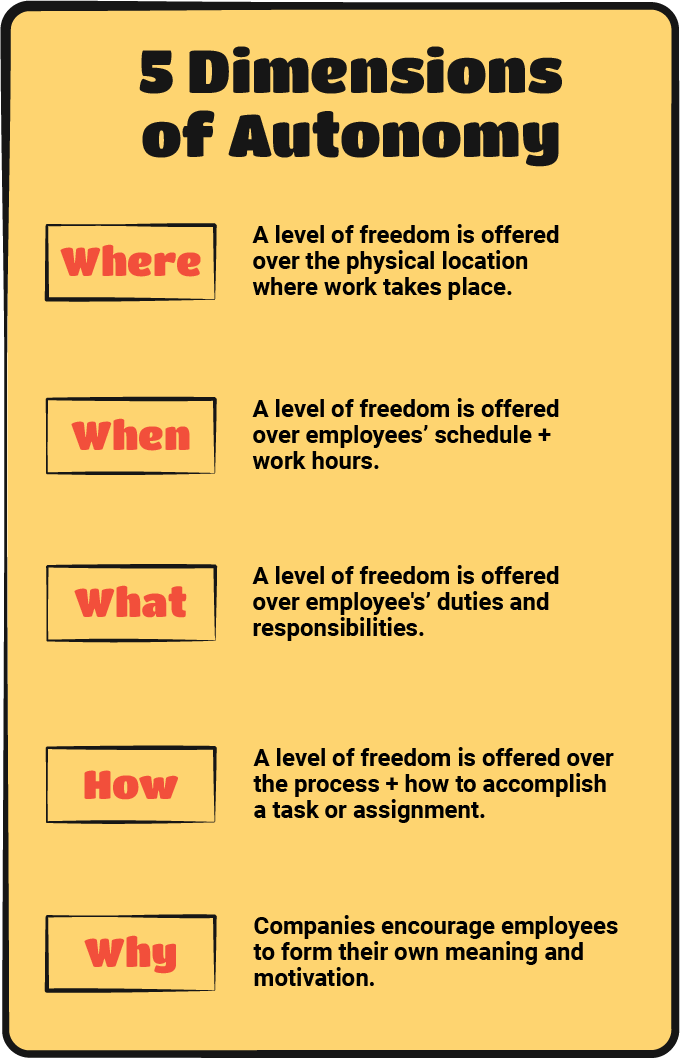In March 2020, a centuries-old institution -- the office, ceased to exist. And, quite literally overnight, millions of knowledge workers got to experience a lot more freedom in their lives.
People were thrilled. Unsurprisingly. Remote work enabled many people to experience a quality of life they never thought possible.
Fast forward, and many workers are reluctant to return to the office. Have you ever tried flying first class, then going back to economy? I am a content writer who is lucky to work from home, but I imagine returning to the office feels a little bit like that -- a step backwards.
To preserve that sense of flexibility and freedom, many people are resorting to quitting their jobs.
It’s become clearer than ever -- autonomy is critical for employee happiness. As a result, many companies are experimenting, giving their employees more autonomy and flexibility than ever before.
But one question remains -- where is the line? How much freedom is too much?
Calming Fears
Employee autonomy is a new frontier for many businesses. There may be doubts and fears about granting this freedom. It's understandable!
Leaders might worry and think worse-case-scenario -- what if people waste company time and do not get any work done? When they should be thinking -- what if this new model gave employees a sense of happiness and satisfaction, compelling them to work harder for us.
In his book Work Rules, Lazlo Bock, the former Head of People Operations at Google, speaks about this idea. He suggests, "give people slightly more trust, freedom, and authority than you are comfortable giving them. If you're not nervous, you haven't given them enough."
Bock is a big believer in employee empowerment and autonomy. In his experience, it never leads to total chaos or anarchy, as some leaders fear.
As he says, when you give employees space to do their best work, "you'll be stunned by what they can accomplish." But, sadly, many leaders don't push past the initial nerves and discomfort. In addition, many misconceptions about employee autonomy exist.
These myths produce even more leadership inertia. In turn, this uncertainty further prevents companies from adopting flexible work models. The very models that could have a dramatic impact on employee engagement and retention.
Pushing past inertia
We understand: Adopting a new way of working can be daunting. And encountering some resistance is common.
This article aims to help your company move past skepticism by first clearing up some common misconceptions about autonomy.
Then we'll look at the five dimensions of autonomy. These are all the ways companies can promote greater employee autonomy. You'll be surprised to see it can be so much more than just offering flexible hours! And even shift workers can be granted more autonomy.
Lastly, we'll give you concrete examples of how any company can apply principles of greater employee autonomy. In the end, you'll have practical ideas to implement in your company.
Demystifying Autonomy: 4 Common Myths
Autonomy at work is almost a contradiction in itself. Work is supposed to happen at set hours, in a particular place, and employees must perform specific tasks. There is a reason why many people struggle to adopt autonomous work models -- it's not how the system is supposed to work! Right?
Many of these rigid work beliefs are remnants of the industrial age. Today's jobs are much different from factory jobs. Moreover, many of these industrial-era models may harm employee health and happiness in the long term. Let's spend a few minutes debunking some of these myths.
Myth 1: Giving autonomy is an "all-or-nothing" strategy
Many leaders mistakenly believe autonomy is a black and white strategy. You either give people total autonomy or keep things traditional and structured -- there is no "grey area" or in between.
This myth is far from the truth: Building a culture of autonomy takes time. For example, companies that run remote teams or ROWE (results-only work environments) didn’t do that overnight. Quite the opposite -- many of them slowly eased themselves into it. In other words, you CAN take baby steps into more autonomy. Taking small steps into more flexible work models can actually help calm leaders’ fears and help workers adapt to the new changes and expectations.
Myth 2: Giving autonomy means letting people run wild and free
The notion of "employee freedom" can trigger an owner's biggest fears -- people slacking off, taking advantage of company time, and not delivering results. Many try to avoid this by doubling down on the opposite of autonomy -- control. But too much top-down control has many damaging side effects on employee psychology.
But what some leaders may not realize is that autonomous teams are actually highly organized and systematic. Because when you give employees freedom over how and when work gets done, everyone must be hyper accountable for the results. As organizational researcher Michael Mankins says in this HBR article, "An essential counterweight to autonomy is strict accountability for results, and for the actions and behaviours that deliver those results."
Myth 3: Shift or manufacturing workers cannot be given more autonomy
Giving employees more autonomy is a great idea -- but it's only for tech people and creative workers. This belief can be deeply ingrained.
Of course, service workers or manufacturing employees can't work from home and must show up for their shifts. But there are many other ways companies can create more freedom and autonomy for employees while they're on site. More on those ideas in the next section!
Myth 4: Giving more autonomy means providing little support
Many people think employee autonomy is the opposite of control. Accordingly, they assume that giving employees autonomy will result in a lack of safety and support from managers.
But in reality, the opposite is true. Even in highly autonomous teams, managers play a critical role. As opposed to delegating tasks and overseeing day-to-day operations, a manager's role in an autonomous environment is to be a mentor, coach, provider of continuous support for their team.
5 Dimensions of Autonomy
This section will be zooming in on the different facets of autonomy and how your company can grant employees more autonomy in each area of work.
As you will see, each one is unique and better suited for specific work environments or industries. Think about which component of autonomy would work best for your organization and employees.
WHERE
Companies may allow employees to choose whether or not to be present in a physical office. The 2020 pandemic accelerates this notion of the physical workplace as even being an option. Even though workers had the technology to work remotely for over a decade, many companies were reluctant to remote work. Naturally, they feared not being able to supervise employees. But now, employees are pushing for remote work benefits. Many companies will have to consider this a top-line tactic to give employees more autonomy.
Different degrees of freedom: At one end of the spectrum, giving employees a lot of autonomy in this area would mean allowing employees to work from wherever they want, not just in their city but in the world. On the other end, companies who grant employees little autonomy in this area mandate employees to be in the office 5-days per week.
WHEN
Traditionally office jobs operate on a 9-5, 40-hour week schedule. And for essential workers like health care employees, shift work is still the norm. Giving employees freedom over their working hours is a novel idea. Many companies are hesitant to break free from traditional models. Still, offering flexible schedules can be a powerful way to drive employee engagement and retention.
Different degrees of freedom: Granting employees total liberty in this area would mean abolishing fixed schedules. Employees choose when to get their work down and are only accountable for the results. Also called ROWE (results-only work environment.) On the flip side, giving employees little autonomy in this area would mean mandating a rigid schedule with an expectation of a minimum amount of hours per week.
WHAT
Traditionally, companies gave workers a set of duties and goals to fulfill. In short, people are hired to fill a predetermined job description. But it’s becoming more common for organizations to find talented people and slowly create jobs around those individuals. Or at the very least, allowing the employee to participate in the discussion and shape their responsibilities.
Different degrees of freedom: Granting a lot of freedom in this area would allow employees full control over their assignments and goals. Conversely, giving little freedom here means dictating what the employee should be working on without considering their preferences or opinions.
HOW
Now we are zooming in to the finer details. The “how” of autonomy means giving employees freedom over the process, in short, allowing them the freedom to experiment and play with different ways of tackling a new task or problem. Or it can also mean simply taking time to gather employee feedback before implementing a change -- allowing employees to exercise their knowledge and expertise.
Different degrees of freedom: Granting a lot of freedom here would mean giving employees full autonomy to decide how to accomplish a goal with little instruction or direction. On the other hand, giving limited freedom on the process means instructing employees exactly how things should be done.
WHY
This factor is an often overlooked part of autonomy. Most companies have a company mission, a long-term "why" that keeps employees motivated. You might have an inspiring mission, but it's likely each employee also has their own personal why. What keeps them motivated? Making an effort to keep employees connected to their "why" can be an excellent technique for motivating employees.
Different degrees of freedom: A company that offers a lot of freedom in this area will try to get to know employees personally and remind them of their personal why. On the other hand, little autonomy in this area can look like companies who force their mission upon their people without holding space for their employees’ unique motivations

Practical Examples of Employee Autonomy
Now you understand the key building blocks of autonomy and the different degrees, let’s offer some real examples. This way, you will have concrete tactics to walk away with and possibly apply in your business.
1. Giving employees a choice of where to work
This idea applies to the physical location of work, allowing employees to choose where they work. In a recent study of over 5,000 knowledge workers worldwide, 77% said they would prefer to work for a company that gives them the flexibility to work remotely.
The idea of a remote option is no longer nice to have; many knowledge workers are expecting this as a default. For example, many companies allow for a hybrid model. Employees are encouraged to work wherever they get their best work done.
2. Allowing employees to establish their own hours
Some people have more energy in the morning, while others have more at night. For many knowledge workers, the idea of tracking hours as a sign of performance is becoming obsolete.
As author Mark Dent says in his recent article To reinvent work, we have to destroy the clock longer hours does not mean better performance. Several studies of companies who implemented this method, such as Best Buy in the mid-2000s, have demonstrated that focusing on employee performance over time has a profound effect on human psychology and, as a result, employee engagement and morale.
3. Allowing employees to set their own goals and objectives
Steve Jobs said it best in his famous quote, "it doesn't make sense to hire smart people and then tell them what to do; we hire smart people so they can tell us what to do." Going to work and being told exactly what to do is sometimes a reality of work. But it doesn't always have to be the case. Giving employees time to work on passion projects (related to their jobs) or giving them a say in their goals can be a powerful way to drive motivation.
4. Before implementing change, give employees an opportunity to give feedback or recommendation
This tactic is a powerful tool in the manager's arsenal. Allowing freedom to give feedback and recommendations based on their experience drives a sense of mastery and confidence. For example, this tactic can profoundly impact employee happiness and engagement for jobs that can't be as flexible regarding "where" and "when" work gets done, like manufacturing workers, customer service or retail work.
Organizational research supports this idea. For example, in 1950, psychologist Alfred Marrow conducted a fascinating experiment at the Harwood clothing factory. He wanted to test the best way to get factory workers to embrace change, so he designed a clever experiment.
Factory workers were asked to adopt a new process, but workers were divided into a few different groups and given varying degrees of control over the new process.
The results were astonishing.
Those who were forced to make changes (without being asked for feedback or recommendations) suffered. There were more complaints, and their productivity dropped by 20% and never recovered. While those asked to participate in change experienced different results, productivity initially dropped as they adapted to the new process. Still, it recovered and exceeded previous rates by 15%.
5. Allow employees to experiment with new ways of doing things
It is highly engaging to experiment with new ways of doing things. The flip side is experimentation is being told exactly what to do and how to do it — giving employees as little power as possible. It's obvious how such strict top-down control can feel dehumanizing and demotivating. Offering employees space to explore new approaches can profoundly impact motivation. It's also a myth that businesses can only apply this tactic to tech or creative workers. Even essential workers, like service employees, can be encouraged to experiment or innovate.
6. Encourage employees to connect with their own meaning and purpose
Imagine a sports coach giving a pep talk to a player mid-game. What would be a more motivating thing to say -- “remember, do this for the money” or “do this for your dad or your kids.”
Doing something in honour of your late parents or simply for the joy of pursuing growth is called intrinsic motivation. Tapping into intrinsic motivation is an effective coaching technique by regularly reminding employees to focus on their own goals to spark a sense of autonomy and purpose at work
Giving employees back control
Dr. Christina Maslach of the University of California is an expert on burnout. In her research, she cites “control” or a lack of it, a key driver of employee burnout.
It’s no wonder that industries that offer less flexibility like service and health care employees have higher rates of employee burnout.
To that end, we should approach employee autonomy, not about granting total freedom and letting employees do whatever they please. It’s about making an effort to give employees varying levels of control over the where, when, what, how and why's of work.
Final Thoughts
It is virtually free to give employees more autonomy. And it is shown by research to have a dramatic impact on employee morale, engagement, and productivity.
Despite the numerous proven benefits, many companies remain stuck in the old ways of doing things.
What does this teach us?
Often, the biggest barriers to change have nothing to do with money, but rather they are rooted in a psychological resistance to new ways of doing things. In this case, some leaders fear the negative consequences of employee autonomy. Perhaps that the work won't get done, or people will take advantage of company time.
But knowledge work differs greatly from physical labour carried out in a factory.
Maybe it's time to abandon some of these antiquated models of the industrial era. Treating knowledge workers like machines is detrimental to human psychology and employee engagement. Companies need to adapt. They can start by giving employees more control over their work and more freedom over the process. Leaders will be stunned by the dramatic impact this simple and cost-effective strategy can have on their employee satisfaction, and in turn, on their business performance.
About the author
 Michelle Cadieux
Michelle Cadieux
Michelle is a content writer for Applauz. She holds a Bachelor's degree in Psychology from Concordia University, and she has been writing about work and employee happiness for over five years.




